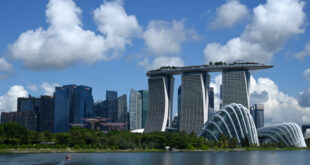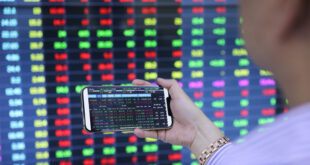A surge in energy, fertilizer, grain, and metal prices is hitting the global economy, and Vietnam cannot be immune to it.
But analysts no longer warn of inflation when talking about the economic risks from the Russia-Ukraine conflict, but rather “stagflation”.
It is a perfect storm with low economic growth, high unemployment and soaring prices.
It will be nearly impossible for Vietnam to escape since its trade to GDP ratio is among the top 10 globally.
In 2020 its ratio was nearly 210 percent.
Surging oil prices would be the most consequential factor, with costs being driven up for most industries, analysts said.
Global oil prices climbed to a 14-year high of almost US$140 per barrel this week.
In Vietnam, gasoline prices skyrocketed by 10 percent to another new record Friday, after authorities adjusted them upward for the seventh time in three months.
The price of popular gasoline RON 95 and biofuel E5 RON 92 both rose from VND26,830 per liter to VND29,820 per liter, and from VND26,070 to VND28,980, respectively. ($1 = VND22,875).
Oil prices have a direct effect on transportation, which currently makes up 9.7 percent of the goods and services basket used to calculate the consumer price index.
Inflation was 1.42 percent year-on-year in February, driven by a 15 percent rise in transport prices.
Food and catering, accounting for 33 percent of the goods basket, were also affected by oil prices.
To ensure adequate supply, Vietnam doubled its oil imports last month.
After Nghi Son, the country’s biggest oil refinery, recently cut its output to 80 percent, the Ministry of Industry and Trade instructed distributors to import 2.4 million cubic meters of gasoline in the second quarter.
Other commodity prices have also been driven up by the conflict in Ukraine.
Russia is one of the world’s major suppliers of coal, steel, base metals, fertilizers, and grains, whose prices have all risen significantly since its military operation began.
Fertilizers and grains for producing animal feed are important to Vietnam’s economy since agriculture, forestry and fisheries make up 12.8 percent of GDP and employ 30 percent of the workforce.
Fertilizer prices have nearly doubled in the last 12 months, while wheat and corn prices are up 9-18 percent since the fighting began.
Gold prices, one of the leading indicators of market confidence, skyrocketed to an all-time high of VND74.4 million per tael [of 37.5 grams or 1.2 ounces] in Vietnam Tuesday, before falling to VND68.1 million per tael on Wednesday.
Dr Nguyen Khac Quoc Bao, head of the Financial Technology Institute (University of Economics HCMC), said the biggest challenge for Vietnamese policymakers is the growth-inflation dilemma.
While it is necessary for the government to keep monetary and fiscal policies loose and increase public investment to support an economic recovery, this would pose a great challenge to inflation control, he said.
The supply chain disruptions and logistics costs are also of concern this year, he added.
Economist Tan Van Luc listed four measures for businesses amid the surging prices topped by diversifying supply and markets.
They also need to diversify the currency of payment, negotiate with partners on transport plans, and review legal documents in the event of disputes.
He also called on the government to provide greater support to businesses.
- Reduce Hair Loss with PURA D’OR Gold Label Shampoo
- Castor Oil Has Made a “Huge” Difference With Hair and Brow Growth
- Excessive hair loss in men: Signs of illness that cannot be subjective
- Dịch Vụ SEO Website ở Los Angeles, CA: đưa trang web doanh nghiệp bạn lên top Google
- Nails Salon Sierra Madre
 VnExpress News The News Gateway of Vietnam
VnExpress News The News Gateway of Vietnam




